The beautiful Golden Temple in Amritsar is the spiritual and cultural centre of Punjab, India.
For centuries, people from all over India have been coming to Amritsar for pilgrimage and spiritual healing.
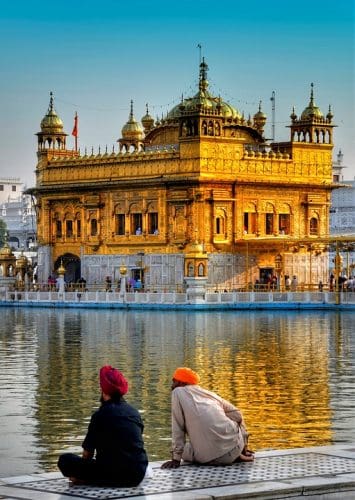
As a pilgrimage centre, the Golden Temple has become a symbol of faith, peace, and harmony for millions. People from all religious backgrounds, faiths, and ages come here to seek blessings, spend time in calm contemplation, and enjoy the beauty of this majestic building.
The Golden Temple is an architectural marvel constructed using white marble and gold plating, with intricate carvings and intricate details. It has four entrances, symbolising the openness and inclusiveness of Sikhism. The Golden Temple is a reminder to people of all backgrounds that there is something greater than our differences.
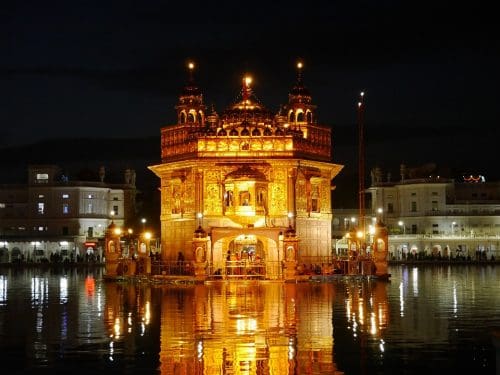
Every day, thousands of devotees come to pay their respects at the Golden Temple and its adjoining lake. From early morning prayers to night-time rituals, the Golden Temple is an experience of spiritual growth and personal development.
The history of Golden Temple
Amritsar is well-known for the majestic and renowned Golden Temple, also known as Sri Harmandir Sahib, which is one of the country’s most important spiritual monuments.
The Temple is a two-story edifice with a top half coated with about 400 kilograms of pure gold leaf, earning it its English name.
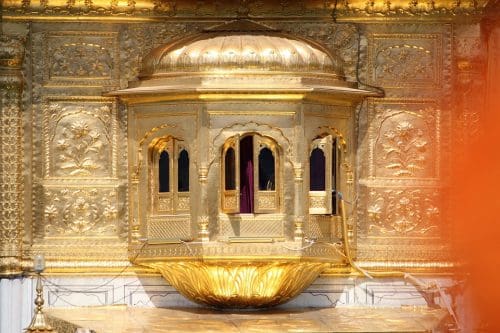
Maharaja Ranjit Singh, the ruler of the Sikh kingdom, is thought to have started the building in the nineteenth century. The rest of the temple complex is made of white marble that has been inlaid with valuable and semi-precious colored stones. The pietra dura approach was selected to produce the motifs. The majestic temple complex is massive in scale.
To show respect, visitors must cover their heads and remove their shoes before stepping inside the Golden Temple. The tranquil atmosphere of the temple comforts the heart as one listens to the exquisite notes of Gurbani (spiritual singing).
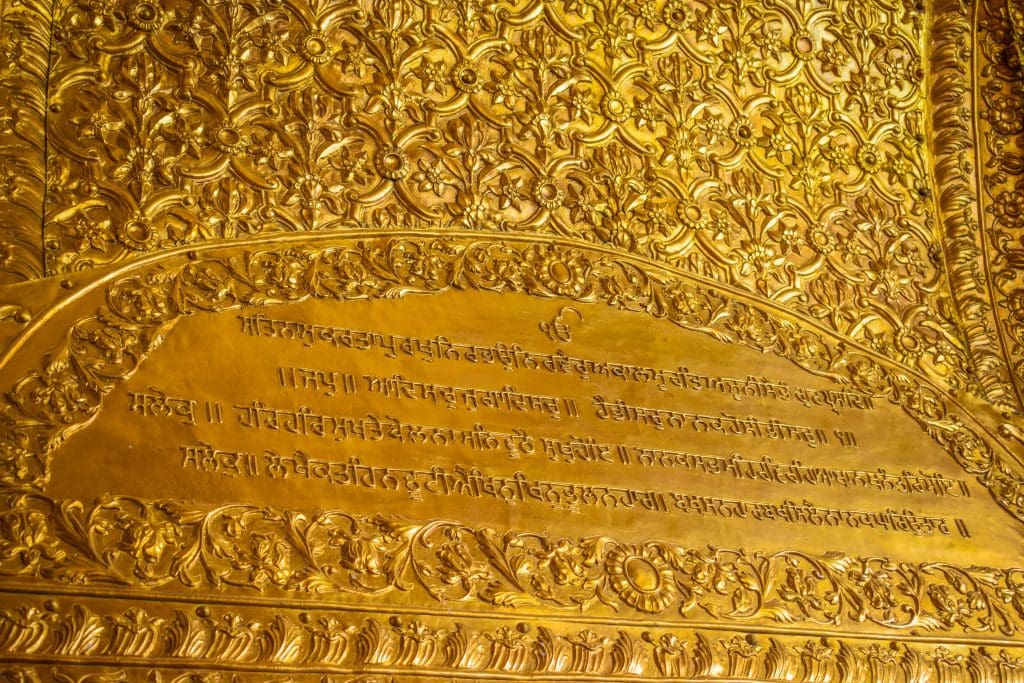
Everyone, regardless of caste, race, or gender, is welcome to join in the free lunch served to about 20,000 people per day at the Guru Ka Langar (community dinner).
The entire system is run by volunteers and is among the most humbling sights one can witness.
The temple’s construction is remarkable, with a 67-foot square of marble serving as the structure’s foundation.
The gleaming temple is accompanied by Amrit Sarovar (nectar pool), the waters of which are supposed to have medicinal properties.
Colorful fish swim in the pure blue waters of the lake as worshippers get a plunge in it. The temple was created with the primary ideals of Sikhism in mind, which support worldwide brotherhood and an all-inclusive attitude. As a result, it is approachable from all sides.
Vaisakhi, which takes place in the second week of April (mostly the 13th of April), is one of the most prominent popular festivals at the Golden Temple.
This celebration is held to honor the Khalsa’s inception.
Other religiously significant holidays include Guru Nanak’s birthday, Guru Ram Das’ birth anniversary, Guru Teg Bahadur’s martyrdom day, and others.
On Diwali, the Harmandir Sahib is beautifully adorned with lights and diyas, as well as a fireworks show. Most Sikhs pay a visit at least once in their lives.
The main entrance has a beautiful clock tower and the Central Sikh Museum although it is still known as ghanta Ghar deori.
The temple and its lovely silhouette in the Amrit Sarovar may be observed starting after this.
Although the clock tower did not exist when the temple was first built, it was rebuilt by the British and today stands in place of the “lost palace.”
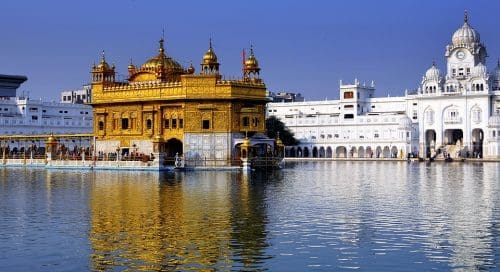
During the Second Anglo-Sikh War, the British dismantled a portion of the structure and replaced it with a clock tower.
The Clock Tower, constructed by John Gordon, was completed in 1874 but was dismantled by Sikhs 70 years later.
A second entrance is through the silver doors of the exquisitely adorned Darshani Deori, which opens onto the causeway that connects the sanctum sanctorum to the Parikrama, the marbled floor that surrounds the Sarovar.
Traditionally, the Golden Temple complex was open, with several trees surrounding the lake.
The temple grounds now include a two-story courtyard with four entrances and three Ber (jujube) tree branches.
The first one is known as the Ber Baba Buddha and may be shown to the right of the ghanta Ghar deori.
The tree was named after Baba Buddha, who sat beneath it while watching the development of the first shrine and lake.
The second tree, known as the Laachi Ber, is thought to be the one within which Guru Arjan slept while the temple was being built.
The third tree, Dukh Bhanjani Bher, would be on the other side of the sanctuary, over the pond.
As per Sikh history, a Sikh was healed of leprosy after taking a plunge in the temple lake’s waters, earning the tree the moniker “suffering reliever.” This tree houses a little gurudwara.
Throughout the daytime, the Granth Sahib, the Sikhs’ sacred book, is kept within the temple.
It is transferred at night to the Akal Takth, or Eternal Throne, which stores historic weapons previously used by Sikh soldiers.
Teja Singh Samundri Hall and Akal Takht: Akal Takht, which means “The crown of the Timeless (God),” is located directly at the front of the central sanctuary.
The site became noted for its ceremonial, spiritual, and secular events after Guru Hargobind established it after his father Guru Arjan. Whereas the Akal Takht at the Golden Temple complex is the central seat and primary power of Sikhism, there are four more Takhts distributed over Anandpur, Patna, Nanded, and Talwandi Sabo that are all prominent spiritual locations for Sikhism.
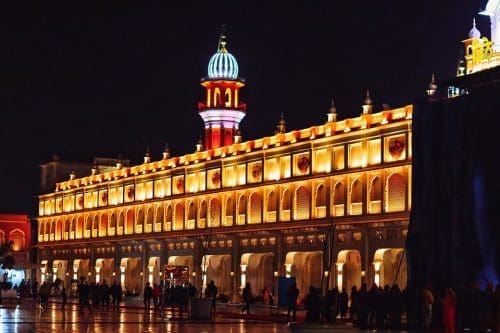
Sikh History Museum
On the first level of the major ghanta Ghar deori is a Sikh museum that shows numerous artworks of the Gurus and martyrs. Swords, Kartar, combs, and chakkars preserved at the museum show Sikh heritage in all its splendor. Other noteworthy temples around Sri Harmandir Sahib include the Durgiana Temple, a magnificent garden, and Baba Atal’s tower. The classic Ramayana is claimed to have been written at this hallowed location by the philosopher Valmiki.
Tips For Visiting Golden Temple
- Before entering the temple enclosure, remove your footwear and socks. Wash your feet in the neighboring small foot tubs.
- Put on proper attire. The body must be entirely covered, and the head must be covered as a gesture of respect at the gurdwara. Scarves may be borrowed for free or purchased from hawkers selling souvenir headbands for Rs 10. It is, nonetheless, advisable to have a scarf with you.
- Alcohol and cigarettes are forbidden.
- If you want to sit next to the pond, cross your legs and avoid dipping your toes under the water.
- Photography is allowed along the walkway that surrounds the lake, but not within the Golden Temple.
- As a symbol of respect, sit on the floor in the Darbar Sahib when hearing Gurbani.
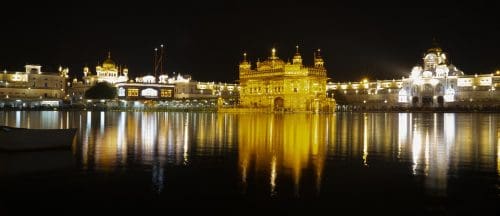
No matter how many times you visit the Golden Temple in Amritsar, it will always be a place of beauty, peace and love. It is a reminder that we are all connected beyond our differences – something to be cherished and respected by all. Try to visit this holy place and experience its divine energy for yourself!
7 Places to visit around Golden Temple
Jallianwala Bagh
If you’ve read a history book and are familiar with India’s liberation movement, the chances of you not knowing about this location are minimal. Jallianwala Bagh is renowned for the carnage carried out by the British Army under General Dyer’s orders.
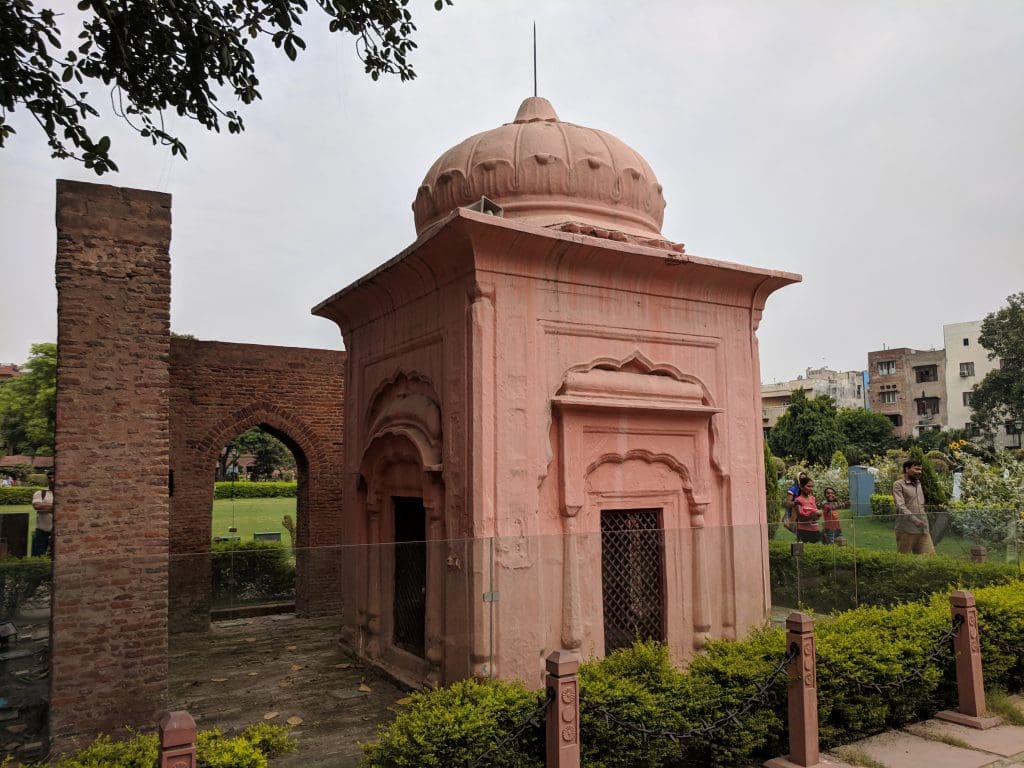
This unfortunate tragedy occurred on the thirteenth of April, 1919. This day was also celebrated as Punjabi New Year. Three hundred and seventy-nine persons were murdered and almost eleven hundred were injured in this tragedy. In commemoration of those who were martyred, a memorial was erected in Jallianwala Bagh in 1951. Many visitors come here to pay their respects to those who died in the atrocity.
Wagah Border
It is a famous tourist destination near the Golden Temple. It is the next most popular travel attraction in Amritsar, trailing only the Golden Temple. The Wagah crossing point is the sole Indian road crossing between Pakistan and India.
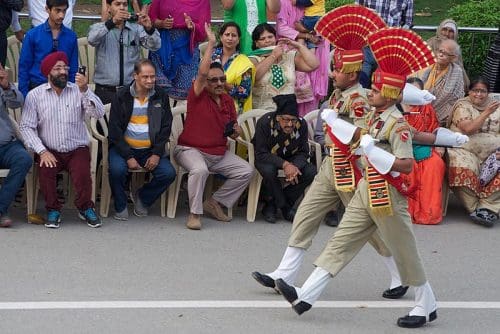
People from all across the nation visit to witness the beating retreat ceremony and the changing of the guard. Seating areas have been created on both sides of the border for people from both nations to appreciate the display of heroism and nationalism. The primary goal of the Wagah Border Ritual is to officially seal the border at nightfall and remove the flags of both countries.
Akal Takht
Amritsar’s Akal Takht is a Sikh shrine erected on the grounds of the Golden Temple. Guru Hargobind Sahib established this shrine. The goal of constructing this temple was to address disputes in a systematic and equitable manner.
This temple is well-known since it is supposed to be the highest place of Khalsa authority. This temple’s name means “the seat of the immortal human.” It is used to symbolize the Sikh folk’s political autonomy. The Sikhs have five takhts, of which it’s part. The temple was formerly known as Akal Bunga. This temple also serves as the Jathedar’s residence. A Jathedar is the Sikhs’ spokesman of the highest order.
Tarn Taran
Tarn Taran, located in the same area, is a Sikh shrine and the greatest spot to explore near the Golden Temple. This Gurudwara was built by Guru Arjan Dev, the fifth Guru of the Sikhs. Saro pond is a lake placed in the heart of the Gurudwara grounds.
The Saro pond is claimed to be the largest in the center of any Sikh temple. It is a major Sikh pilgrimage destination throughout the nation. Each month on Amavasya, or the New Moon, Sikh worshippers congregate here. From 1980 through 1990, this location witnessed a Sikh revolt. When in Amritsar, you must visit here to witness the historical splendor.
Maharaja Ranjit Singh Museum
Maharaja Ranjit Singh Museum is in the loving memory of Maharaja Ranjit Singh, as the name implies. He was widely regarded as the “Lion of Punjab.” The museum has exhibits and information on Maharaja Ranjit Singh’s life.
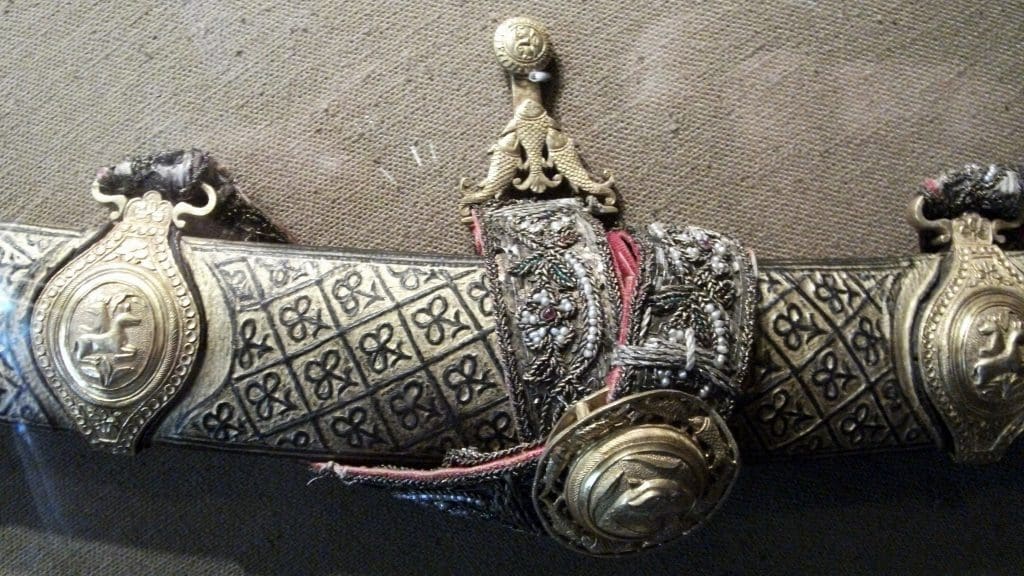
There are several relics at the museum that serve as mementos of his many wars. The magnificent light and sound spectacle is something you must not miss when visiting here. The light and sound show here will leave you feeling as if you are in a big war, making it among the best locations to experience near Golden Temple.
Bathinda Fort
Bathinda Fort is one of the country’s oldest forts. This fort stands thirty meters tall. The fort built by Raja Dab is a sight to see. This fort is well-known for its relation with Sultana Razia’s captivity. The Archaeological Survey of India maintains the fort, and the government has designated it as a national heritage landmark. Thus, it is a historical fort in the Bhatinda district and is one of the finest locations to be near the Golden Temple.
Ram Tirath Temple
Ram Tirath Temple is one of the most important Hindu sites, revered for its religious, historical, and spiritual importance in Hinduism. The temple is situated on Amritsar-Chogawan Road and is linked with several Ramayana stories. This location is also renowned as the birthplace of Lord Ram’s sons, Lav and Kush. It is also widely believed that Sage Valmiki began composing the Ramayana here, at one of the most religious tourism sites near the Golden Temple.
Famous food specialties in the holy city of Amritsar
Food is an important part of the Amritsar culture, and it is definitely worth experiencing if you find yourself in this holy Golden City.
From local Punjabi favourites like Amritsari Kulcha, Sarso Ka Saag, and Makki Ki Roti to sweet delights like Jalebis, Kheer, and Halwa, Amritsar has something to offer everyone’s taste buds.
Explore its culinary delights because the local fare is sure to tantalize your taste buds.
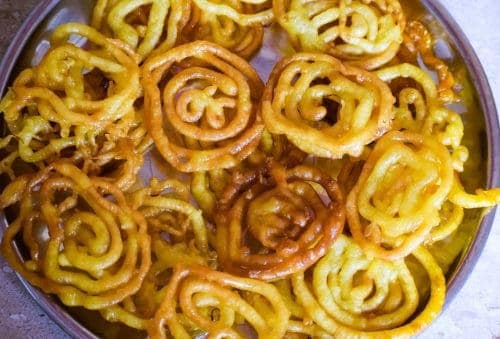
Don’t miss out on tasting the local favorite – jalebis, which is made from a batter is made using flour, sugar, yoghurt, and spices. This batter is then deep-fried in oil or ghee until golden brown and crispy. It is then served hot with a sprinkle of saffron syrup to give it that sweet taste and aroma. Those who visit the Golden Temple are in for an extra special treat – the jalebis here have a unique flavor because of the ghee used in its preparation.
The halwa is a favourite among locals as well as visitors due to its sweet taste and inviting aroma. The delicious Halwa is a rich, gooey dessert made from flour, sugar, and ghee. It is popular in the Golden City of Amritsar because of its delicious taste and the nuts and raisins which bring it extra flavor.
Langar
The Golden Temple is also home to the world-famous Langar – a free meal served throughout the day in the Golden Temple complex. Langar is a communal meal served at Golden Temple in Amritsar. It is prepared and served by volunteers as part of the temple’s Sikh religion.
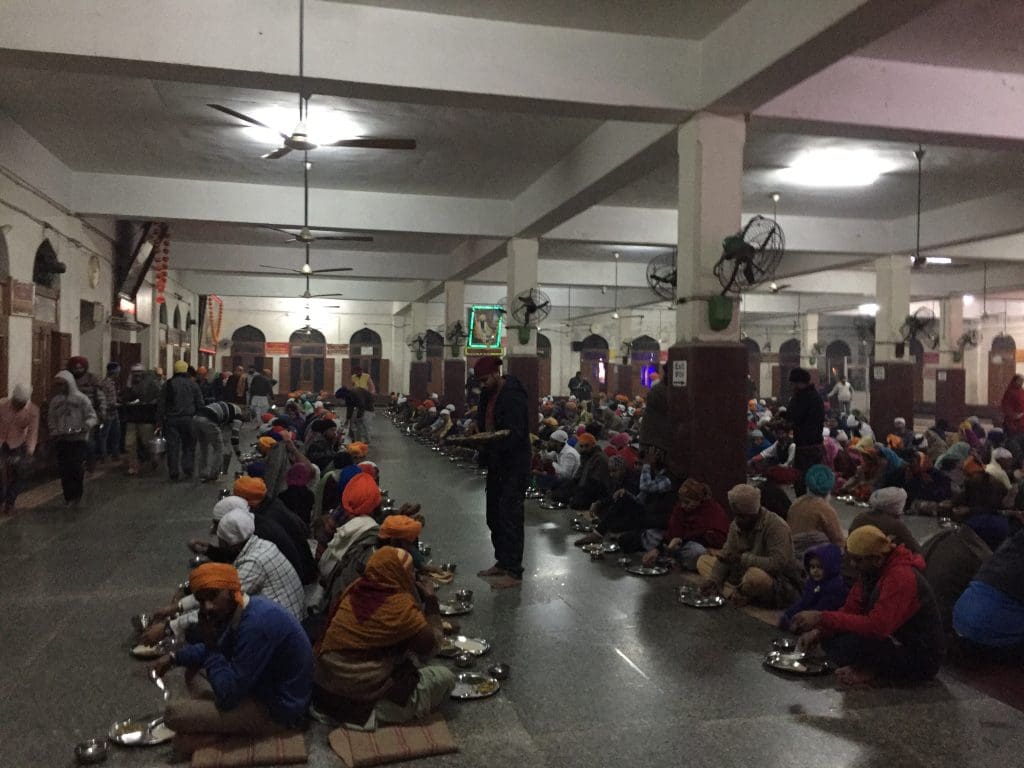
The purpose of langar is to provide a sense of equality among people from all walks of life, regardless of caste, class, or creed. The meal consists of lentils, vegetables, and roti, which is a flatbread. Golden Temple also serves items such as kheer (rice pudding) or halwa (a sweet dessert made from flour, sugar, and ghee). Eating in the langar hall is a spiritual experience that is not to be missed!
Try out a range of delicious Punjabi food that can be found in restaurants around the temple.
Famous food stalls in streets and alleys around the Golden Temple serve hot and spicy snacks such as samosas, pakoras, and chaat (a mix of fried potatoes, spices, yogurt, and tamarind chutney).
There’s also a variety of sweet treats available including jalebis (deep-fried pastry dipped in sugar syrup), barfi (milk-based fudge), and kulfi (traditional Indian ice cream).
Read More: Latest



